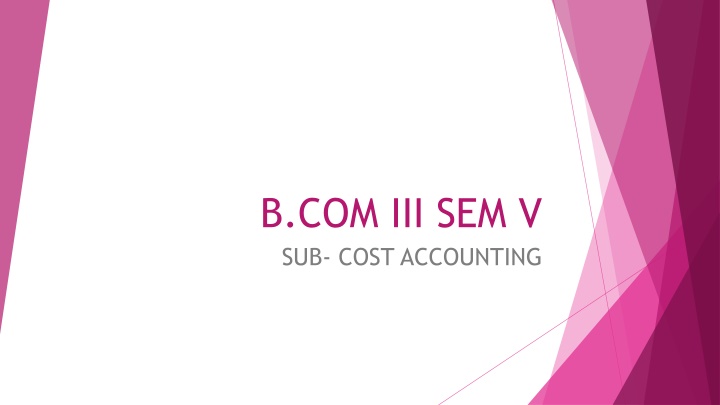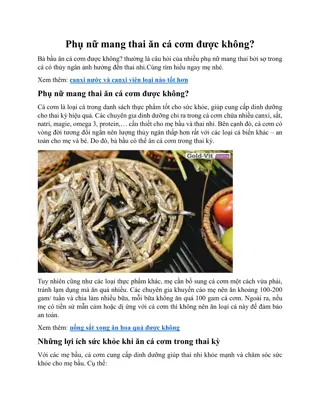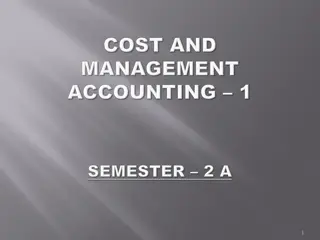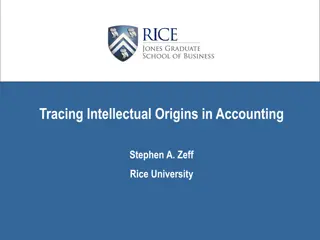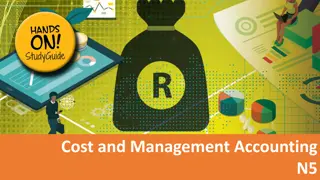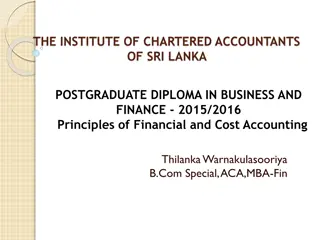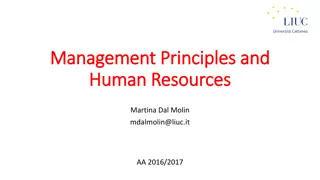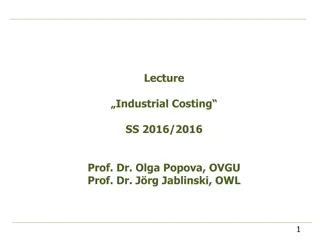B.Com III - Cost Accounting Statement
This content discusses the statement of cost for the year ending, detailing various cost components such as materials, wages, factory expenses, and more. It also includes a reconciliation statement for profit assessment in cost accounts.
Download Presentation

Please find below an Image/Link to download the presentation.
The content on the website is provided AS IS for your information and personal use only. It may not be sold, licensed, or shared on other websites without obtaining consent from the author.If you encounter any issues during the download, it is possible that the publisher has removed the file from their server.
You are allowed to download the files provided on this website for personal or commercial use, subject to the condition that they are used lawfully. All files are the property of their respective owners.
The content on the website is provided AS IS for your information and personal use only. It may not be sold, licensed, or shared on other websites without obtaining consent from the author.
E N D
Presentation Transcript
B.COM III SEM V SUB- COST ACCOUNTING
STATEMENT OF COST For The Year Ending . Particulars Add: Opening Stock of Materials XXX Materials Purchased XXX Total Cost Per Unit XXX Less: Closing Stock of Materials XXX XXX Add: Carriage Inwards XXX (A) Material Consumed XXX Productive Wages (B) Prime Cost Add: Works Oncost: Factory Rent And Taxes XXX Factory Insurance XXX XXX XXX XXX XXX XXX XXX XXX XXX
Particulars Add: Opening Work-In-Progress Total Cost XXX XXX XXX XXX XXX XXX XXX XXX XXX XXX XXX XXX XXX XXX Per Unit + XXX XXX Less: Closing Work-in-Progress (C) Works Cost Add: Office Oncost (D) Production Cost Add: Opening Stock of Finished Goods - XXX XXX + XXX XXX XXX XXX - XXX XXX XXX XXX XXX XXX Less: Closing Stock of Finished Goods (E) Cost Of Goods Sold Add: Sales And Distribution Expenses Add: Net Profit (F) Selling Price
RECONCILIATION STATEMENT Particulars Rupees Rupees XXX Profit As Per Cost Accounts Add: (i) Over Recovery or Overcharge or Over Absorption of Overheads in Cost Accounts: 1) Factory Overheads 2) Office Overheads 3) Selling & Distribution Overheads ii) Overvaluation of Opening Stock in Cost Account: 1) Raw Material 2) Work-In-Progress 3) Finished Goods iii) Undervaluation of Closing Stock in Cost Accounts: 1) Raw Material 2) Work-In-Progress 3) Finished Goods ----------- ----------- ----------- ----------- XXX ----------- ----------- -----------
Particulars Rupees Rupees iv) Items of Income, Gains and Profits entered in Financial Accounts but not considered in Cost Account: 1) Interest 2) Rent 3) Dividend v) Items of Expenditure and Losses shown in Cost Accounts but not shown in Financial Accounts. vi) Depreciation Overcharged in Cost Accounts. ----------- ----------- ----------- XXX ----------- ----------- XXX XXXX Less: i) Under-recovery or absorption of Overheads in cost accounts ii) Undervaluation of Opening Stock Of Material, Work-In-Progress and Finished Goods in Cost Accounts. iii) Overvaluation of Closing Stock of Raw Material, Work-In-Progress and Finished Goods in cost Accounts. ----------- ----------- -----------
Particulars Rupees Rupees vi) Items of Expenditure Debited in Financial Accounts but Excluded in Cost Accounts. ----------- v) Items or Income or Gains shown in Cost Accounts but not considered in financial accounts. ----------- XXX vi) Depreciation Undercharged in Cost Accounts. Profit as per Financial Accounts ----------- XXX XXXX
PROCESS - ACCOUNTS Particulars To Opening Stock To Transfer from earlier Process To Material To Wages To Direct Expenses To Other Expenses To Abnormal Gain Units ------- ------ Particular By Normal Loss A/c By Abnormal Loss A/c By By-Product A/c By Transfer of Output to Stores By Transfer of Output to Next Process A/c By Closing Stock Units ------- ------- ------- ------- ------ ------ ------- ------- ------- ------- ------- ------- ------- ------- ------- ------ ------ ------ ------ ------ ------- ------- ------- ------- ------- -------
BREAK EVEN POINT (I) Calculating Profit at Different Sales Volume 1) Profit = Sales Variable Cost Fixed Cost 2) Profit = Contribution Margin Fixed Cost 3) Profit = Sales x Profit Volume Ratio Fixed Cost 4) Per Unit Contribution = Fixed Cost Break Even Point (Unit) 5) Per Unit Selling Price = Per Unit Contribution + Per Unit Variable Cost 6) New Volume of Sales = Fixed Cost + Profit (In Units) New Selling Price (Per Unit) Variable Cost (Per Unit)
7) Desired Sales = Fixed Cost + Desired Profit (Per unit ) Selling Price per unit Variable cost per unit 8) Desired Sales = Fixed Cost + Desired Profit (Per Unit) Per unit Contribution 9) Desired Sales = Total Fixed Cost + Desired Profit 1- Per unit Variable Cost Per Unit Selling Price 10) Desired Sales = Fixed Cost x Desired Profit Profit Volume Ratio 11) Margin of Safety = Total Sales Break Even Point 12) Margin of Safety = Profit x Sales Contribution 13) Break Even Point (Rs.) = Fixed Cost Profit Volume Ratio (%)
13) Margin of Safety = Profit Profit Volume Ratio 14) Contribution = Sales Variable Cost 15) Contribution = Fixed Cost + Profit 16) Contribution = Fixed Cost Loss 17) Sales = Variable Cost + Contribution 18) Variable Cost = Sales Contribution 19) Contribution Ratio = Sales Variable Cost x 100 Sales 20) Margin of Safety (Price) = Total Sales (Price) Break Even Point Sales (Price) 21) Margin of Safety (Unit) =Actual Sales (Unit) Break Even Point Sales (Unit) 22) Margin of Safety = Profit Profit Volume Ratio 23) Profit Volume Ratio = Sales - Variable Cost Sales
24) Profit Volume Ratio = Fixed Cost + Profit Sales 25) Profit Volume Ratio = Contribution x 100 Sales 26) Profit Volume Ratio = Sales Variable Cost x 100 Sales 27)Profit Volume Ratio = Fixed Cost + Profit Sales 28) Break Even Point = Fixed Cost x Sales Contribution 29) Break Even Point = Fixed Cost (Unit) (Unit) Per Unit Sales Price Per Unit Variable Cost 30) Break Even Point (Rs.) = Fixed Cost (Total) 1 - Variable Cost (Per Unit) Sales Per Unit
